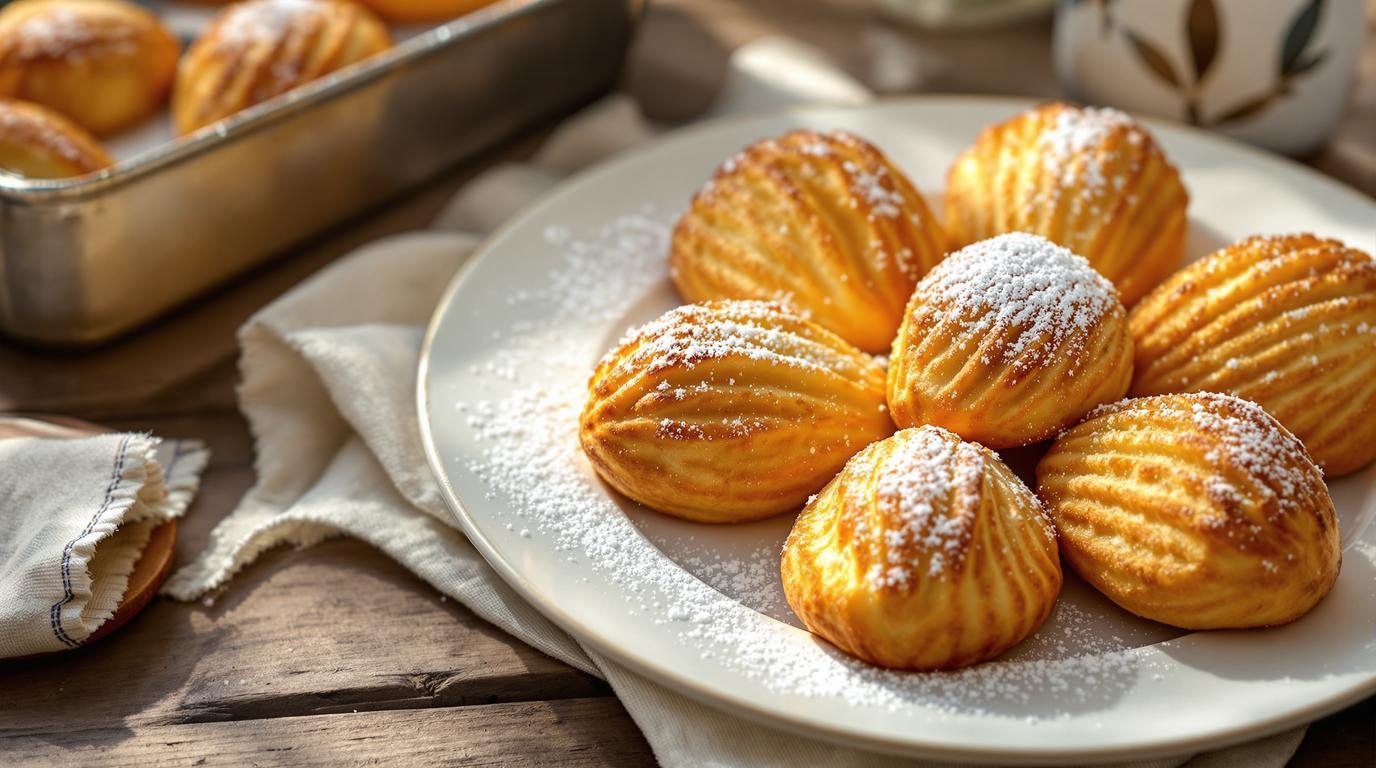The first time I encountered true French madeleines wasn’t in Paris but in a tiny seaside town in Normandy. I’d stepped into a local pâtisserie seeking shelter from unexpected rain and found myself watching an elderly woman unmolding these perfectly golden shell-shaped cakes. The aroma was intoxicating—butter, vanilla, and something indefinably nostalgic. One bite of those warm, just-baked madeleines transformed my understanding of this classic. The secret? Patience. The batter had rested overnight, creating that signature hump that distinguishes perfect madeleines from merely good ones. Today, I’m sharing my version of this timeless recipe that honors tradition while being entirely achievable in your home kitchen.
The Story 📖
Madeleines occupy a special place in French culinary tradition, immortalized by Marcel Proust in his novel “In Search of Lost Time,” where a single bite evoked a flood of childhood memories. While often categorized as cookies, they’re actually delicate little sponge cakes with a distinctive shell shape and characteristic hump. Originating from the Lorraine region in northeastern France, traditional madeleines balance simplicity with technique. What sets grandmother-style madeleines apart is their pronounced hump and tender, buttery crumb—characteristics that come from resting the batter and controlling temperature during baking. After perfecting this recipe in restaurants from Lyon to New York, I’ve distilled it to its essential elements while maintaining its soul.
Ingredients Spotlight 🧪
For 12-16 madeleines:
- 150g (10½ tbsp) unsalted European-style butter, plus extra for the pan
- 2 large eggs, room temperature
- 100g (½ cup) granulated sugar
- 1 tbsp honey (preferably acacia or wildflower)
- 1 tsp vanilla extract or ½ vanilla bean, seeds scraped
- 120g (1 cup) all-purpose flour
- 1 tsp baking powder
- ¼ tsp fine sea salt
- Zest of one small lemon (optional but recommended)
- Powdered sugar for dusting
Step-by-Step Guide 📝
1. Brown the butter: In a small saucepan, melt butter over medium heat. Continue cooking until it turns golden brown and smells nutty (about 5-7 minutes). Strain through a fine-mesh sieve into a bowl and let cool to room temperature.
2. Make the batter: In a stand mixer fitted with the whisk attachment, beat eggs and sugar on medium-high speed for 3-4 minutes until pale and tripled in volume. Beat in honey, vanilla, and lemon zest if using.
3. Incorporate dry ingredients: Sift together flour, baking powder, and salt. Using a flexible spatula, gently fold the dry ingredients into the egg mixture in three additions, maintaining as much air as possible.
4. Add butter: Take about ¼ cup of the batter and stir it into the cooled brown butter. Then fold this mixture back into the main batter until just incorporated—no streaks, but don’t overmix.
5. Rest: Cover the bowl with plastic wrap and refrigerate for at least 4 hours, preferably overnight (up to 24 hours). This step is non-negotiable for authentic results.
6. Prepare for baking: Preheat oven to 425°F (220°C). Brush madeleine pan thoroughly with melted butter, then dust with flour, tapping out excess. Place pan in freezer for 5 minutes.
7. Bake with temperature control: Fill each shell indentation about ¾ full (about 1 tablespoon of batter). Bake at 425°F (220°C) for exactly 3 minutes, then reduce temperature to 350°F (175°C) and bake for 5-7 minutes more until edges are golden and the centers spring back when touched.
8. Unmold immediately: Tap the pan firmly against the counter, then turn madeleines out onto a cooling rack. Dust with powdered sugar while still warm.
Expert Techniques 🛠️
The characteristic hump of a perfect madeleine comes from thermal shock—the contrast between cold batter hitting a hot oven. To maximize this effect, I always chill my batter overnight, then freeze my buttered madeleine pan before filling. The initial high heat blast (425°F) creates steam that pushes the center upward, while the subsequent lower temperature (350°F) ensures even cooking without burning.
Chef’s Note: When browning butter for madeleines, push it just to the edge where it smells nutty but before it turns too dark. Those toasty milk solids contain incredible flavor compounds that elevate these simple cakes from good to transcendent. Just be vigilant—the difference between perfectly browned and burnt is mere seconds.
Another crucial technique is proper pan preparation. Traditional metal pans conduct heat better than silicone alternatives, creating more defined edges and better browning. Brush every ridge with melted butter, then dust with flour—this creates a barrier that helps the madeleines release cleanly while forming a delicate crust.
Presentation & Pairing Ideas 🍽️
Serve madeleines still warm, when their contrast between crisp exterior and tender interior is most pronounced. For an elegant presentation, arrange them overlapping slightly on a white plate with their shell-side up, lightly dusted with powdered sugar. They pair beautifully with espresso or tea—particularly Earl Grey or jasmine. For a more substantial dessert, serve alongside fresh berries and lightly whipped cream infused with a touch of vanilla.
For seasonal variations, try folding in 1 teaspoon of orange blossom water in spring, 2 teaspoons of culinary lavender in summer, or ½ teaspoon of ground cardamom in winter. For a chocolate version that still maintains the classic texture, replace 20g of flour with cocoa powder.
The beauty of madeleines lies in their ephemeral nature—they’re best consumed within hours of baking when their contrast of textures is most pronounced. Like memories themselves, their perfect state is fleeting, which is perhaps why Proust found them so evocative. Don’t be afraid to play with the flavor profile once you’ve mastered the technique—a touch of matcha powder, a hint of citrus, or even a splash of your favorite liqueur can create your own memory-making variation. Remember, the best recipes evolve while honoring their roots. Explore other French classics like Blanquette de Veau, Beef Bourguignon, or Cassoulet to continue your French culinary journey. For dessert lovers, try my Chocolate Pistachio Brownies or venture into Italian territory with a simple Pizza Bianca.
